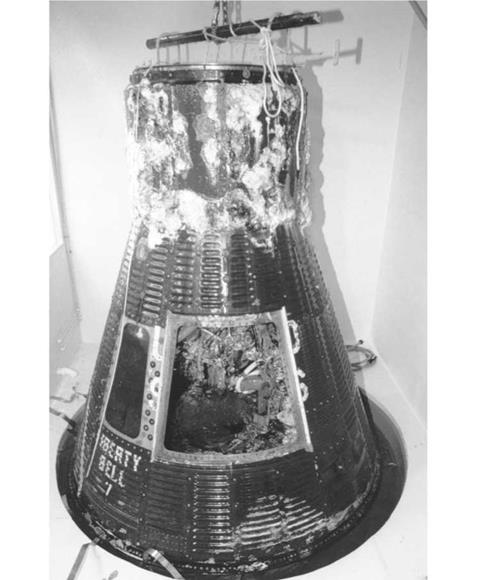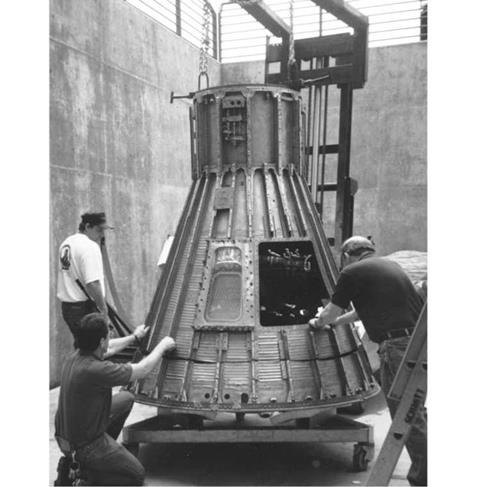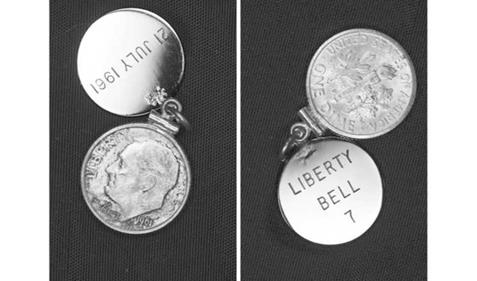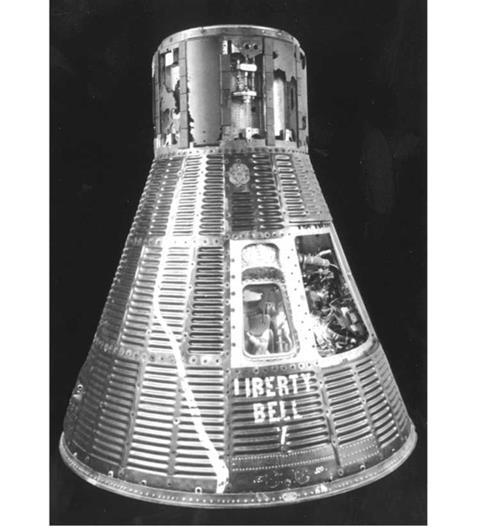A RESTORATION TASK LIKE NO OTHER
In researching this book, I happened across an extremely well written article in the Spring 2000 (Vol.7, No.4) issue of the quarterly history of space flight magazine, Quest, penned by Connecticut-based space writer Keith Scala. Under the title, The Future of Liberty Bell 7, his article related the manner in which the spacecraft had undergone meticulous restoration at the Kansas Cosmosphere and Space Center and the plans for its subsequent exhibition. I contacted Keith to ask if he might consider updating his article as a feature in this book, to which he happily agreed. Here then, is the post-recovery story of Liberty Bell 7.
THE RESTORATION OF LIBERTYBELL 7
Keith J. Scala
After Liberty Bell 7 was removed from the expedition ship Ocean Project at Port Canaveral, the capsule was transported to the Kansas Cosmosphere and Space Center in Hutchinson, Kansas on 1 September 1999. The capsule was shipped overland in a container filled with seawater to prevent further corrosion
The Kansas Cosmosphere is the only private museum authorized by the Smithsonian Institution to restore U. S. manned spacecraft. One previous spacecraft restored there in 1997 was the Apollo 13 command module Odyssey. Several other spacecraft from the United States and Russia have also been restored at the Midwestern facility.
|
Liberty Bell 7 arrives at the Kansas Cosmosphere. (Photo courtesy of the Kansas Cosmosphere and Space Center) |
|
Max Ary, the Kansas Cosmosphere’s president, explains the restoration process the spacecraft would undergo. (Photo: Kansas Cosmosphere and Space Center) |
In the case of Liberty Bell 7, the Kansas Cosmosphere was given ownership of the spacecraft. In fact, Liberty Bell 7 is the only manned American spacecraft not owned by NASA or the Smithsonian. Since NASA and the Smithsonian had never planned to recover Liberty Bell 7, it was agreed that the Kansas Cosmosphere would retain ownership of the ill-fated capsule. Before the successful recovery operation NASA gave ownership to the Discovery Channel. After recovery the ownership was then transferred to the Kansas Cosmosphere. This was done to help reimburse the cost and time of the recovery effort.
The intention of the Kansas Cosmosphere was to clean every portion of the spacecraft and remove parts that had been so badly damaged by corrosion that it would not be feasible to restore them. Max Ary, past president and CEO of the Kansas Cosmosphere, said at the time, “We will disassemble the entire spacecraft, individually cleaning every single piece, from the exterior shingles to the smallest of screws. Our goal is not to make the spacecraft look brand new,” Ary added. “We simply want to clean and preserve it so that it will be available for generations to come. We will reassemble the spacecraft with only the original parts. If we need a particular part (the original part was too badly damaged), for example, a panel into which switches need to be mounted, we will create one of Plexiglas or we will create a metal skeleton that will serve the same purpose. Either way, it will be obvious to the viewer which pieces of Liberty Bell 7 did not survive the 38 years in a harsh deep-sea environment.” The Plexiglas or framework has the added benefit of allowing the viewer to see the interior of the spacecraft not normally seen. The cleaning also stabilized the capsule so no additional deterioration would occur after the restoration.27
The overall condition of Liberty Bell 7 was surprisingly good after its 38-year stay at the bottom of the Atlantic. First, 75 gallons of mostly sand and other things that live in the ocean were removed from the capsule. Many metal parts, mostly those made of aluminum, were excessively corroded while items like paper and plastic had been preserved. The superstructure of the capsule was intact. The capsule control panels had corroded away but many switches and gauges were in excellent condition. Some glass face plates on the gauges had been shattered by the water pressure.
The capsule structure has two layers; firstly, an outer skin of Rene 41 alloy shingles used to protect the capsule from reentry heat. The shingles are bolted to the inner titanium structure with aircraft-style stringers in between. This method provided for a gap between the outer and inner structures. The gap allowed ceramic fiber to be used for extra thermal insulation. The inner structure serves as a pressure vessel to retain air pressure. The outer skin shingles were removed as well as all the interior equipment. The words UNITED STATES and even the “Liberty Bell” crack painted on the outer skin remained.
A harsh but necessary method had to be used after the outer alloy shingles were removed. Since technicians could not remove the lower bulkhead of the inner structure, as it was welded to the bottom of the conical inner structure, it was decided to cut the capsule into two pieces. The cut was made between the entry hatch and lower bulkhead around the diameter of the capsule.
This allowed access to each of the 24 framed aircraft-style stringers that run vertically inside. The lower half and top half of the capsule could then be sandblasted free of corrosion. When the capsule was reassembled and the outer alloy shingles were attached to the inner structure the cut would not be evident.28
Many interesting items were found inside the capsule. The film inside a camera that kept a record of Grissom’s movements was not salvageable, but it was hoped that a magnetic tape with Grissom’s voice during the flight could be saved. A roll of Mercury dimes intended to be given to Grissom’s friends was discovered, several of which were revealed at the capsule’s Port Canaveral homecoming. Several silver dollar certificates bearing Grissom’s signature were also found. The dollar bills had been rolled up and deliberately hidden inside plastic shrink-wrap tubing to look like part of the interior wiring. More than likely technicians would have removed these after the flight (as described earlier in this book) as mementos of the flight.
A checklist and grease pencil Grissom used during the flight was still in useable shape. A metal cap that covered the explosive hatch detonator was found, but did not shed any light as to why the hatch blew, causing the capsule to flood. Curiously enough, a bar of Dial soap was still in its paper wrapper and in good shape, even though several metal parts of the capsule had corroded away. One last item of interest is a portion of Teflon cable attached to the top of the capsule. This cable had been used by the Marine helicopter in a vain attempt to pull the capsule from the water, but had to be cut when the capsule started to pull the helicopter down.29
The restoration process took approximately seven months and cost $250,000. It involved 7,280 manned hours and 30,000 parts, while 10 miles of wiring had to be removed from the spacecraft and replaced. During the restoration process a webcam broadcast pictures of the spacecraft 24 hours a day, allowing Internet viewers to
|
Liberty Bell 7 after removal of the outer shingles. Note the cut made to the capsule under the hatch. (Photo courtesy of the Kansas Cosmosphere and Space Center) |
follow the restoration process. Visitors to the Kansas Cosmosphere were able to view the restoration of Liberty Bell 7 from the other side of a Plexiglas wall.
After the restoration was completed, no definitive information was found on why the hatch mysteriously blew after splashdown. If the hatch itself had been found (it was never recovered) it might have given some answers. Had Liberty Bell 7 not been lost, it also could have been helpful to the official investigation into the accident in 1961.
|
|
The Mercury head dimes found inside Liberty Bell 7. (Photo: NASA/KSC, ID KSC-99PP-1035)
|
|
A number of recovered Roosevelt dimes carried by Gus Grissom eventually found their way onto the collectors’ market. (Photo: The Skyman1958 collection)
|
Liberty Bell 7 after restoration. (Photo courtesy of the Kansas Cosmosphere and Space Center) |
When the restoration process was finished, the Discovery Channel took Liberty Bell 7 on a tour of North America. An interactive 6,000 square-foot traveling exhibit was used with Liberty Bell 7 as the centerpiece. The tour started in 2000 and lasted six years. After the tour was completed, Liberty Bell 7’s final home was the Kansas Cosmosphere. Should any future space historians wish to reopen the investigation into how the hatch blew back in 1961, Liberty Bell 7 will be waiting in Kansas to help answer the mystery.
















